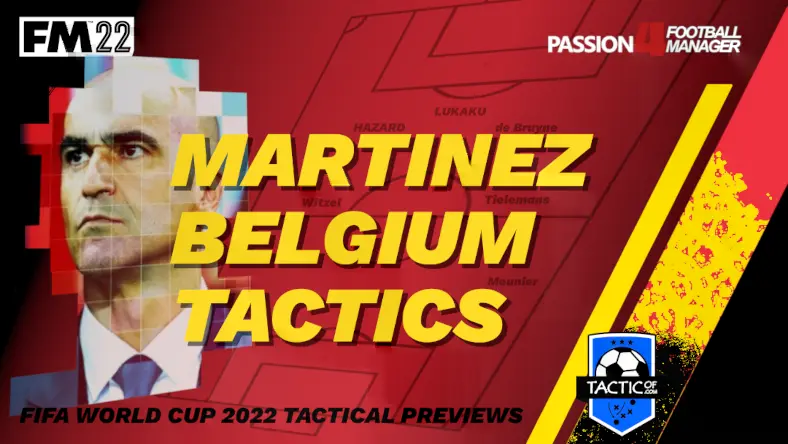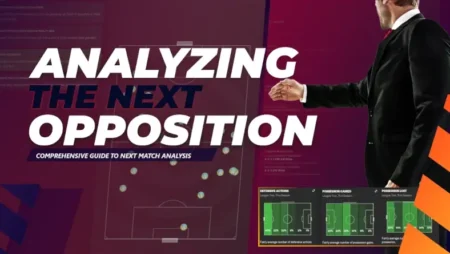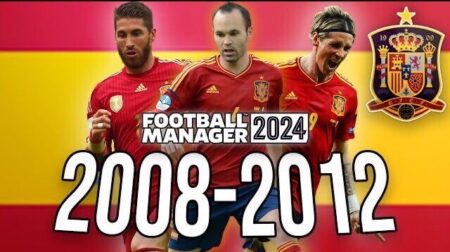Over the next few months tacticof will give you a World Cup Qatar 2022 tactical preview by looking at the qualified teams’ tactics and manager’s profile, and how you could replicate their tactics in Football Manager!
This time is a tactical preview of Roberto Martinez Belgium Tactics for Football Manager 2022. For further information about Martinez’s manager profile, please check out Martinez’s Manager profile on tacticof.com.
Belgium, no 2 in the FIFA ranking, will be one of the favorites to progress from the World Cup 2022 Group F, especially since they ended up in a rather weak group with Croatia, Canada and Morocco. So far, Belgium is still yet to win the World Cup trophy, but with their golden generation at their prime, this might be their best chance to lift the World Cup trophy for the first time?! If so, then Roberto Martinz must show coaching in masterclass.
With this tactical preview, you’ll get a better insight to Roberto Martinez Belgium tactics and Martinez’s preferred use of roles and duties for Qatar 2022 World Cup.
Keep reading to learn more about how you can replicate Roberto Martinez Belgium Tactics on Football Manager 2022 with its team instructions, player roles and duties.
PS! Available in the bottom of the article, is an opportunity to download the Football Manager 2022 Roberto Martinez Belgium tactics by tacticof.
Roberto Martinez Belgium World Cup 2022 Tactics Explained via Football Manager 2022
Formation & Shape
Roberto Martinez prefers to play three at the back using his favoured 1-3-4-2-1 with Romelu Lukaku on the top. In this shape Martinez tends to have a cautious (even defensive) mentality with patient playmaking in search of the best possible shooting position.
Martinez relies heavily on the individual skills of his players. Belgium’s defensive formation usually resembles 1-5-2-3 (less often 1-5-4-1) with the wing-backs moving forward immediately after gathering the ball to assume 1-3-2-5 shape in attack.

Belgium base their game on ball possession, but their actions are patient and slow with no emphasis on progressive vertical passes to offensive players, hence long direct passes to fast strikers are rare and differentiate the Belgians’ play rather than being a scheme of play.
Tielemans and de Bruyne are the two key playmakers who make the most direct passes, but it is the central defenders who determine the depth and tempo at which the action is built in its first phase. It is worth noting that the three stoppers usually line up in a straight line and instead of creating different angles in the triangle, they exchange short passes among themselves looking for options among the central midfielders.
This allows the defence to become more compact when losing the ball, but also limits the tempo and direction of play in the first phase. Tielemans plays deeper while allowing de Bruyne to seek space more freely.
The wingers (both as Inverted Winger roles) are also used in the initial phases of building action (i.e. Hazard on the left wing), but only to provide width of the play, which has a natural tendency to play down to the centre of the pitch in the early stages of the action. This allows the centre to become overloaded, increases the number of options in wide attacks and provides the three defenders with high positions.

In defense the Belgians do not press too hard waiting for their rivals to make a mistake and saving their energy for a fast attack. They line up in medium to low pressing with the wingers dropping back providing a tight formation in a 1-5-2-3 or 1-5-4-1 system. Pressing consists of trying to receive the ball between the lines with one midfielder (Tielemans) going deeper towards the central defenders. When they play using a defensive midfielder (Witsel, Dendoncker) they release the other midfielder (Tielemans or de Bruyne) from pressing and allow him to go higher – up to and including the box area, where he is sometimes even the recipient of a fast direct pass if the ball is intercepted.

Possession of the ball is the key to controlling and dominating the match. Belgium’s game is based primarily on short passes and sequences of movement in tight sectors with dribbling and running power secondarily. They do not rush with progressive passes, nor do they push for crossing the midfield line. The shape of the formation and the individual skills of the players help them create triangles in the wide areas between the outside centre defender, the winger and the central midfielder. After all they are able to move very quickly and smoothly from defense to attack with mobile offensive players. When this option is closed they move on to slowly build up the action from the deep.
If they are unable to penetrate rival’s defense in this way they try to change positions and off-ball movements. Wingers and defenders alternate between the wings and the centre, while de Bruyne for example is given more freedom.
A striker (Lukaku, Benteke) often stays back to goal and is looking for a tackle and a place to shoot. Without a natural attacking partner the midfielders will try to create different angles for him to receive and shoot from. By absorbing defenders the striker also opens up space for other players entering the box such as Hazard or de Bruyne.






